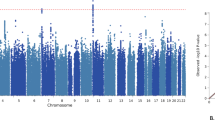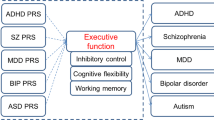Abstract
The search for genetic factors predisposing to Attention Deficit Hyperactivity Disorder (ADHD) has focused on genes that regulate dopaminergic pathways such as dopamine receptors and enzymes that regulate levels of dopamine in the synapse. There have been several reports of association between ADHD and polymorphic variants within or near DRD4, DRD5, DAT1, DBH and COMT. In this study we set out to investigate specific alleles of DRD4 and DRD5, previously reported to be associated with ADHD, in a sample of Turkish children with DSM-IV ADHD children, as well as their relation to methylphenidate response and dimensional measures of symptom domains. One hundred and four independent trios and seven dyads were analysed using the transmission disequilibrium test (TDT). We found increased transmission of the DRD4 7-repeat allele (DRD4*7) (TDT χ2 = 2.79, P = 0.047). Given that we were testing specific a priori hypotheses regarding the associated alleles, we have used one-tailed P-values throughout. There was evidence of an interaction with methlyphenidate (MPH) response and analysis of the sample excluding non-responders revealed more significant evidence for the association (TDT χ2 = 4.48, P = 0.017). We also detected a trend for linkage and association in the DRD5 polymorphism (TDT χ2 = 2.38, P = 0.06). Similar findings were obtained in relation to MPH response as analysis of MPH responders alone gave rise to a more significant association than that of the group as a whole (TDT χ2 = 4.9, P = 0.013). t-Test and logistic regression TDT analyses of DRD4*7 transmission with respect to dimensional rating scales of hyperactivity and impulsivity showed an inverse relation suggesting that in this sample DRD4*7 is associated with a lower level of ADHD symptomatology. While this may be due to stratification along a dimension of severity such that severe cases belong to a more extreme group with other specific genetic and environmental causes, similar to the model for low cognitive ability, it is more likely the result of a chance selection bias in this sample.
This is a preview of subscription content, access via your institution
Access options
Subscribe to this journal
Receive 12 print issues and online access
$259.00 per year
only $21.58 per issue
Buy this article
- Purchase on Springer Link
- Instant access to full article PDF
Prices may be subject to local taxes which are calculated during checkout
Similar content being viewed by others
References
Taylor E, Chadwick O, Heptinstall E et al. Hyperactivity and conduct problems as risk factors for adolescent development J Am Acad Child Adolesc Psychiatry 1996; 35: 1213–1226
Swanson J, Castellanos FX, Murias M et al. Cognitive neuroscience of attention deficit hyperactivity disorder and hyperkinetic disorder Curr Opin Neurobiol 1998; 8: 263–271
Cantwell DP . Psychiatric illness in families of hyperactive children Arch Gen Psychiatry 1972; 27: 728–738
Biederman J, Faraone SV, Keenan K et al. Family-genetic and psychosocial risk factors in DSM-III attention deficit disorder J Am Acad Child Adolesc Psychiatry 1990; 29: 526–533
Biederman J, Faraone SV, Keenan K et al. Further evidence for family-genetic risk factors in attention deficit hyperactivity disorder: patterns of comorbidity in probands and relatives in psychiatrically and pediatrically referred samples Arch Gen Psychiatry 1992; 49: 728–738
Stevenson J . Evidence for a genetic aetiology in hyperactivity in children Behav Genet 1992; 22: 337–344
Goodman R, Stevenson J . A twin study of hyperactivity I and II. An examination of hyperactivity scores and categories derived from Rutter teacher and parent questionnaires J Child Psychol Psychiat 1989; 30: 671–689
Thapar A, Holmes J, Poulton K et al. Genetic basis of attention deficit and hyperactivity Br J Psychiatry 1999; 174: 105–111
Levy F, Hay DA, McStephen M et al. Attention-deficit hyperactivity disorder: a category or a continuum? Genetic analysis of a large-scale twin study J Am Acad Child Adolesc Psychiatry 1997; 36: 737–744
Eaves LJ, Silberg JL, Meyer JM et al. Genetics and developmental psychopathology: 2. The main effects of genes and environment on behavioral problems in the Virginia Twin Study of Adolescent Behavioral Development J Child Psychol Psychiatry Allied Discip 1997; 38: 965–980
Shekim WO, Javaid J, Davis JM et al. Urinary MHPG and HVA excretion in boys with attention deficit disorder and hyperactivity treated with d-amphetamine Biol Psychiatry 1983; 18: 707–714
Shen YC, Wang YF . 3-methoxy-4-hydroxyphenylglycol sulfate excretion in 73 schoolchildren with minimal brain-dysfunction syndrome Biol Psychiatry 1984; 19: 861–870
Zametkin AJ, Karoum F, Rapoport JL . Phenylethylamine excretion in attention deficit disorder J Am Acad Child Psychiatry 1984; 23: 310–314
Arnold LE, Abikoff HB, Cantwell DP et al. National Institute of Mental Health Collaborative Multimodal Treatment Study of Children with ADHD (the MTA): design challenges and choices Arch Gen Psychiatry 1997; 54: 865–870
Gainetdinov RR, Wetsel WC, Jones SR et al. Role of serotonin in the paradoxical calming effect of psychostimulants on hyperactivity Science 1999; 283: 397–401
Shaywitz BA . CSF amine metabolites in children with minimal brain dysfunction (MBD): evidence of involvement of brain dopamine J Pediatr 1977; 90: 67–71
Goldman-Rakic PS . Topography of cognition: parallel distribution networks in primate association cortex Ann Rev Neurosci 1992; 11: 137–156
Lahoste GJ, Swanson JM, Wigal S et al. Dopamine D4 receptor gene polymorphism is associated with attention-deficit hyperactivity disorder Mol Psychiatry 1996; 1: 121–124
Swanson JM, Sunohara GA, Kennedy JL et al. Association of the dopamine receptor D4 (DRD4) gene with a refined phenotype of attention deficit hyperactivity disorder (ADHD): a family-based approach Mol Psychiatry 1998; 3: 38–41
World Health Organisation . International Classification of Diseases: 10th edn WHO: Geneva 1999
Rowe DC, Stever C, Giedinghagen LN et al. Dopamine DRD4 receptor polymorphism and attention deficit hyperactivity disorder Mol Psychiatry 1998; 3: 419–426
Smalley SL, Bailey JN, Palmer CG et al. Evidence that the dopamine D4 receptor is a susceptibility gene in attention deficit hyperactivity disorder Mol Psychiatry 1998; 3: 427–430
Faraone SV, Biederman J, Weiffenbach B et al. Dopamine D4 gene 7-repeat allele and attention deficit hyperactivity disorder Am J Psychiatry 1999; 156: 768–770
Asherson P, Virdee V, Curran S et al. Association study of DSM-IV attention deficit hyperactivity disorder (ADHD) and monoamine pathway genes Neuropsychiatric Genet 1998; 81: 549
Gill M . Unpublished data, 1999
Castellanos FX, Lau E, Tayebi N et al. Lack of an association between a dopamine-4 receptor polymorphism and attention-deficit/hyperactivity disorder: genetic and brain morphometric analyses Mol Psychiatry 1998; 3: 431–434
Ebstein RP, Novick O, Umansky R et al. Dopamine D4 receptor (D4DR) exon III polymorphism associated with the human personality trait of Novelty Seeking Nature Genet 1996; 12: 78–80
Benjamin J, Li L, Patterson C et al. Population and familial association between the D4 dopamine receptor gene and measures of Novelty Seeking Nature Genet 1996; 12: 81–84
Paterson AD, Sunohara GA, Kennedy JL . Dopamine D4 receptor gene: novelty or nonsense? Neuropsychopharmacology 1999; 21: 3–16
Daly G, Hawi Z, Fitzgerald M et al. Mapping susceptibility loci in attention deficit hyperactivity disorder: preferential transmission of parental alleles at DAT1, DBH and DRD5 to affected children Mol Psychiatry 1999; 4: 192–196
Cook JE, Stein MA, Krasowski MD et al. Association of attention-deficit disorder and the dopamine transporter gene Am J Hum Genet 1995; 56: 993–998
Gill M, Daly G, Heron S et al. Confirmation of association between attention deficit hyperactivity disorder and a dopamine transporter polymorphism Mol Psychiatry 1997; 2: 311–313
Waldman ID, Robinson BF, Feigon SA . Linkage disequilibrium between the dopamine transporter gene (DAT1) and bipolar disorder: Extending the transmission disequilibrium test (TDT) to examine genetic heterogeneity Genet Epidemiol 1997; 14: 699–704
Bailey JN . DRD4 gene susceptibility to attention deficit hyperactivity disorder: differences in familial and sporadic cases Am J Med Gen (Neuropsych Gen) 1997; 74: 623 (abstract)
Tahir E . No association between ADHD and polymorphisms in DAT1 and DBH Unpublished data 1999
Sunohara RK, Guan HC, O'Dowd BF, Seeman P, Laurier LG et al. Cloning of the gene for a human dopamine D5-receptor with higher affinity for dopamine than D1 Nature 1991; 350: 614–619
Asghari V, Sanyal S, Buchwaldt S et al. Modulation of intracellular cyclic AMP levels by different human dopamine D4 receptor variants J Neurochem 1995; 65: 1157–1165
Asghari V, Schoots O, Van Kats S et al. Dopamine D4 receptor repeat: analysis of different native and mutant forms of the human and rat genes Mol Pharmacol 1994; 46: 364–373
Kaufman J, Birmaher B, Brent D et al. Schedule for affective disorders and schizophrenia for school-age children–present and lifetime version (K-SADS-PL): initial reliability and validity data J Am Acad Child Adolesc Psychiatry 1997; 36: 980–988
Conners CK, Barkley RA . Rating scales and checklists for child psychopharmacology Psychopharmacol Bull 1985; 21: 809–843
Achenbach TM . Manual for the Child Behaviour Checklist 1991; Department of Psychiatry, University of Vermont, Burlington
Greenhill LL, Abikoff HB, Arnold LE, Cantwell DP, Conners CK, Elliott G et al. Medication treatment strategies in the MTA Study: relevance to clinicians and researchers J Am Acad Child Adolesc Psychiatry 1996; 35: 1304–1313
Lichter JB, Barr CL, Kennedy JL et al. A hypervariable segment in the human dopamine receptor D4 (DRD4) gene Hum Mol Genet 1993; 2: 767–773
Spielman RS, McGinnis RE, Ewens WJ . Transmission test for linkage disequilibrium: the insulin gene region and insulin-dependent diabetes mellitus (IDDM) Am J Hum Genet 1993; 52: 506–516
Schaid DJ, Sommer SS . Genotype relative risks: methods for design and analysis of candidate-gene association studies Am J Hum Genet 1993; 53: 1114–1126
Sham PC, Curtis D . An extended transmission/disequilibrium test (TDT) for multiallele marker loci Ann Hum Genet 1995; 59: 323–336
Waldman ID, Robinson BF, Rhee SH . A logistic regression extension of the transmission disequilibrium test for continuous traits: application to linkage disequilibrium between alcoholism and the candidate genes DRD2 and ADH3 Genet Epidemiol 1999; 17 Suppl1: S379–S384
Curtis D, Sham PC . Population stratifications can cause false positive linkage results if founders are untyped Ann Hum Genet 1996; 60: 261–263
Risch N, Merikangas K . The future of genetic studies of complex human diseases Science 1996; 273: 1516–1517
Eaves IA, Bennett ST, Forster P, Ferber KM, Ehrmann D, Wilson AJ et al. Transmission ratio distortion at the INS-IGF2 VNTR Nature Genet 1999; 22: 324–325
O'Donovan MC, Owen MJ . Candidate-gene association studies of schizophrenia Am J Hum Genet 1999; 65: 587–592
Pliszka SR . Comorbidity of attention-deficit/hyperactivity disorder with psychiatric disorder: an overview J Clin Psychiatry 1998; 59 Suppl7: 50–58
Sobell JL, Lind TJ, Sigurdson DC et al. The D5 dopamine receptor gene in schizophrenia: identification of a nonsense change and multiple missense changes but lack of association with disease Hum Mol Genet 1995; 4: 507–514
Asherson P, Mant R, Williams N et al. A study of chromosome 4p markers and dopamine D5 receptor gene in schizophrenia and bipolar disorder Mol Psychiatry 1998; 3: 310–320
Acknowledgements
We would like to acknowledge the European Molecular Biology Organisation (EMBO), the UK Medical Research Council (MRC), TUBITAK, and Eczacibasi Scientific Research and Award fund for their financial support. We also thank the families who participated in this research.
Author information
Authors and Affiliations
Rights and permissions
About this article
Cite this article
Tahir, E., Yazgan, Y., Cirakoglu, B. et al. Association and linkage of DRD4 and DRD5 with attention deficit hyperactivity disorder (ADHD) in a sample of Turkish children. Mol Psychiatry 5, 396–404 (2000). https://doi.org/10.1038/sj.mp.4000744
Received:
Revised:
Accepted:
Published:
Issue Date:
DOI: https://doi.org/10.1038/sj.mp.4000744
Keywords
This article is cited by
-
Dopamine Receptor Expression and the Pathogenesis of Attention-Deficit Hyperactivity Disorder: a Scoping Review of the Literature
Current Developmental Disorders Reports (2022)
-
Pharmacogenetics of methylphenidate response and tolerability in attention-deficit/hyperactivity disorder
The Pharmacogenomics Journal (2017)
-
A candidate gene investigation of methylphenidate response in adult attention-deficit/hyperactivity disorder patients: results from a naturalistic study
Journal of Neural Transmission (2016)
-
Positive effects of methylphenidate on hyperactivity are moderated by monoaminergic gene variants in children with autism spectrum disorders
The Pharmacogenomics Journal (2014)
-
The association between dopamine receptor (DRD4) gene polymorphisms and second language learning style and behavioral variability in undergraduate students in Turkey
Molecular Biology Reports (2014)



